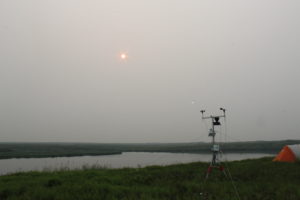
Wildfire smoke over the tundra (photo: WHRC/Natalie Baillargeon)
A few weeks ago, I wrote a blog in transit about the journey I was about to embark on to the tundra. In that fashion, I am now writing a blog reflecting on the journey as we begin the long trek back to Massachusetts. I am still running on the tundra adrenaline of field life as I struggle to encapsulate my inspiring experience into this short forum blog.
One of the most remarkable aspects of this trip was the weather conditions. When preparing for the trip, all of the students are reminded constantly to prepare for very warm to very cold or very dry to very wet, any mixture of that, as the weather can change rapidly in the tundra. That could not be understated for the trip this year.
For several days, we harvested plant samples or surveyed lakes under record-breaking heat with temperatures climbing to about 90 F, quite above average. After one particularly long day, we watched in fear and excitement as a lightning show took place above us. Cloud-to-ground lightning is not completely unusual. Lighting strikes were the cause of the fires that we study while we are there. But, it was the first time in camp’s three-year history to see lightning. We also spent several days working under a haze of smoke from nearby wildfires. We worked under conditions that constantly reminded us that the Arctic climate is changing rapidly.
On top of the unusual weather conditions, this summer field season was riddled with abnormalities. Often, we take measurements of the depth of soil thaw. This year, the thaw depths were almost unbelievable. We measure the thaw by sticking a meter-long stick with handlebars into the ground pulling it up where it hits the frozen layer and measuring from that point to the end of the stick. For the first time this year, it was common in some areas for the thaw to be greater than a meter. This suggests that the active layer may not be freezing in the winter, which has large consequences on the ecosystem.
Further, we witnessed an unusual number of insects – many bees, spiders, and caterpillars, to name a few. Usually, we see many mosquitos and an occasional spider or beetle. But, there were even days where it was too warm and dry for mosquitoes to be out. While it may be nice not to be covered in a bug shirt and lather afterbite lotion on, these signs were unsettling.
For many of these reasons, Alaska is on the front lines of climate change in the United States. The Arctic is experiencing dramatic rates of warming compared to the rest of the globe, accelerating changes in the landscape. For a brief two weeks, we were able to observe these changes. They serve as a strong reminder that climate change is not a near-future threat but a present one.
— Natalie Baillargeon is a student at Hampshire College and member of The Polaris Project classes of 2018 and 2019



